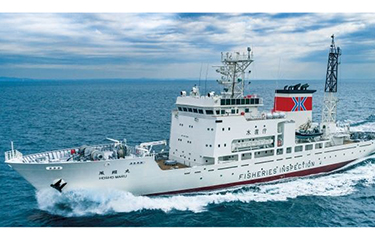Japan’s Fisheries Agency has released its annual Fisheries White Paper, covering trends in fisheries and aquaculture, the supply and demand patterns of fiscal-year 2021, and the impacts of the pandemic on the country’s seafood industry.
The white paper starts off with a review of Japan’s fifth Basic Fisheries Plan, a five-year guideline for systematically promoting fisheries-related measures based on Japan’s Basic Act on Fisheries.
The new basic fisheries plan for FY 2022 was formulated in March 2022, and is based on the major fisheries reforms in 2020 that changed management for most species in Japan from a total allowable effort (TAE) system to a total allowable catch (TAC) system aiming for maximum-sustainable yield (MSY). In order to implement such a system, the number of stock surveys and the species covered by them will be greatly increased. Monitoring of poaching will also be enhanced by replacing fishery control vessels and negotiating with neighboring countries.
Japan is also moving toward an individual transferrable quota system for some species. For management of mixed fisheries, the agency is working on resource management agreements with fishery cooperatives that include stock assessments and management targets.
For bluefin tuna, TAC is allocated among Japan’s prefectures. When the TAC for juvenile bluefin is exceeded, the fish must be released. When larger bluefin exceed the allocation, the location and number must be reported to the agency. If large numbers are caught, the agency can order a period during which retaining large bluefin is also prohibited.
For aquaculture, Japan’s strategy for the growth is focused on increasing exports of yellowtail, seabream, scallops, and cultured pearls. Additionally, the Fisheries Agency is trying to help deal with the economic decline of fishing villages by promoting seafood-related tourism, such as recreational fishing. Increased mechanization and introduction of information and communications technology is also being promoted.
Other trends affecting fishing are declines in fish stocks that may be related to climate change Japan’s shrinking population due to a low birthrate, changes in consumption due to COVID-19, promotion of the United Nations' Sustainable Development Goals (SDGs), carbon neutrality, and the progress of digitalization.
The COVID-19 pandemic resulted in a shift in public consumption patterns in Japan from eating out to eating at home. Across Japan, demand is increasing for home-use frozen foods that can be stocked, are easy to cook, and are convenient. The sales value of fresh seafood temporarily jumped in FY 2020 as people stayed home and cooked, but resumed a downward trend in FY 2021, falling 4 percent. Consumers also purchased more seafood online in response to the pandemic.
In terms of exports, Japan’s seafood exports decreased in 2020, but rebounded in 2021, again due to COVID-19-related fluctuations in demand in destination countries.
The pandemic also changed labor patterns in Japan, with more technical intern trainees staying in Japan due to immigration restrictions, providing an important labor source for the country. As COVID-related entry restrictions have been relaxed in Japan, the agency has made efforts to facilitate the entry of more seafood-sector workers into the country.
The pandemic also had an impact on Japan's self-sufficiency rate of edible seafood versus the amount it needs to import, which recovered slightly in FY 2020 to 57 percent. Japan’s self-sufficiency peaked at 113 percent in 1964, and then trended lower until a low of 53 percent for three consecutive years from 2000 to 2002.
Japan's annual consumption of seafood per capita peaked at 40.2 kilograms in FY 2001, and was 23.4 kilograms in FY 2020, 1.9 kilograms less than FY 2019. Aannual per capita meat consumption surpassed that of seafood for the first time in FY 2011 and continues to rise. Since 2013, food prices in Japan have been rising, particularly for meat and seafood. The decline in consumption of seafood has corresponded with rise in prices.
A "Survey on Awareness and Intentions on Food, Agriculture and Fisheries" conducted by Japan's Ministry of Agriculture, Forestry, and Fisheries, found those purchasing seafood did so for health and because it tastes good while those who eat less seafood do so because their family members prefer meat, and because seafood is expensive and troublesome to cook. As a result, the agency will seek to promote seafood that is convenient to prepare while emphasizing health effects of fish, including the “functional foods” status of EPA and DHA.
The white paper also reviewed the lingering impacts of the Great East Japan Earthquake. While the physical facilities of 70 percent of seafood processors had been restored to at least 80 percent of the capacity they had before the quake and tsunami of 2011, only 50 percent said that their sales have recovered to the 8 percent level. The main reasons were a lack of raw materials (declines in catches), a loss of sales channels during the period when their products were unavailable, and a shortage of workers.
The agency is continuing to work on dispelling rumors and safety concerns about radiation, especially as the government recently decided to discharge treated cooling water from the TEPCO Fukushima Daiichi Nuclear Power Station accident into the sea.
The agency has been working to try and get countries that still have bans on seafood from the region to lift them, citing Japan’s system for preventing foods exceeding safety levels for radioactivity from entering the market. Some of those efforts have appeared to work, as the U.K. lifted restrictions on Japanese food products related to radionuclides on 29 June, 2022. Japan has maintained that seafood caught in the regions near the Fukushima incident are now safe to eat in normal quantities.
Despite the efforts, China, South Korea, Taiwan, Hong Kong, and Macau all retain import measures on Japanese food.
Photo courtesy of Japan's Fisheries Agency







